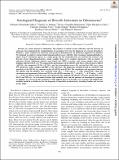| dc.contributor.author | Hernández-Mora, Gabriela | |
| dc.contributor.author | Manire, Charles A. | |
| dc.contributor.author | González-Barrientos, Rocío | |
| dc.contributor.author | BARQUERO-CALVO, ELIAS | |
| dc.contributor.author | Guzman-Verri, Caterina | |
| dc.contributor.author | Staggs, Lydia | |
| dc.contributor.author | Thompson, Rachel | |
| dc.contributor.author | Chaves-Olarte, Esteban | |
| dc.contributor.author | Moreno, Edgardo | |
| dc.date.accessioned | 2020-10-19T22:01:05Z | |
| dc.date.available | 2020-10-19T22:01:05Z | |
| dc.date.issued | 2009-04-15 | |
| dc.identifier.uri | http://hdl.handle.net/11056/18371 | |
| dc.description.abstract | Brucella ceti causes disease in Odontoceti. The absence of control serum collections and the diversity of
cetaceans have hampered the standardization of serological tests for the diagnosis of cetacean brucellosis. Without a “gold” standard for sensitivity and specificity determination, an alternative approach was followed. We designed an indirect enzyme-linked immunosorbent assay (iELISA) that recognizes immunoglobulins G (IgGs) from 17 odontocete species as a single group. For the standardization, we used Brucella melitensis and Brucella abortus lipopolysaccharides, serum samples from seven resident odontocetes with no history of infectious disease displaying negative rose bengal test (RBT) reactions, and serum samples from seven dolphins infected with B. ceti. We compared the performance of the iELISA with those of the protein G ELISA (gELISA), the competitive ELISA (cELISA), and the immunofluorescence (IF) and dot blot (DB) tests, using 179 odontocete serum samples and RBT as the reference. The diagnostic potential based on sensitivity and specificity of the iELISA was superior to that of gELISA and cELISA. The correlation and agreement between the iELISA and the gELISA were relatively good (Ri/g 2 0.65 and i/g 0.66, respectively), while the correlation and agreement of these two ELISAs with cELISA were low (Ri/c 2 0.46, Rg/c 2 0.37 and i/c 0.62,
g/c 0.42). In spite of using the same anti-odontocete IgG antibody, the iELISA was more specific than were the IF and DB tests. An association between high antibody titers and the presence of neurological symptoms in dolphins was observed. The prediction is that iELISA based on broadly cross-reacting anti-dolphin IgG antibody would be a reliable test for the diagnosis of brucellosis in odontocetes, including families not covered in this study. | es_ES |
| dc.description.abstract | Brucella ceti causa la enfermedad en Odontoceti. La ausencia de colecciones de suero de control y la diversidad de cetáceos han obstaculizado la normalización de las pruebas serológicas para el diagnóstico de la brucelosis de los cetáceos. Sin una norma "de oro" para la determinación de la sensibilidad y la especificidad, se siguió un enfoque alternativo. Se diseñó un ensayo inmunoenzimático indirecto (iELISA) que reconoce las inmunoglobulinas G (IgG) de 17 especies de odontocetos como un único grupo. Para la estandarización, utilizamos Brucella melitensis y Brucella abortus lipopolisacáridos, muestras de suero de siete odontocetos residentes sin historial de enfermedades infecciosas que mostraron reacciones negativas a la prueba de rosa de bengala (RBT), y muestras de suero de siete delfines infectados con B. ceti. Comparamos el rendimiento del iELISA con el de la proteína G ELISA (gELISA), el ELISA de competición (cELISA), y las pruebas de inmunofluorescencia (IF) y de "dot blot" (DB), utilizando 179 muestras de suero de odontocetos y RBT como referencia. El potencial de diagnóstico basado en la sensibilidad y la especificidad del iELISA fue superior al del gELISA y el cELISA. La correlación y la concordancia entre el iELISA y el gELISA fueron relativamente buenas (Ri/g 2 0,65 e i/g 0,66, respectivamente), mientras que la correlación y la concordancia de estos dos ELISA con el cELISA fueron bajas (Ri/c 2 0,46, Rg/c 2 0,37 e i/c 0,62, g/c 0,42). A pesar de utilizar el mismo anticuerpo IgG antiodontocetos, el iELISA fue más específico que las pruebas IF y DB. Se observó una asociación entre los altos títulos de anticuerpos y la presencia de síntomas neurológicos en los delfines. La predicción es que el iELISA basado en el anticuerpo IgG anti-delfín de reacción cruzada amplia sería una prueba fiable para el diagnóstico de la brucelosis en los odontocetos, incluyendo familias no cubiertas en este estudio. | es_ES |
| dc.language.iso | eng | es_ES |
| dc.publisher | American Society for Microbiology | es_ES |
| dc.rights | Acceso abierto | es_ES |
| dc.rights | Attribution-NonCommercial-NoDerivatives 4.0 Internacional | * |
| dc.rights.uri | http://creativecommons.org/licenses/by-nc-nd/4.0/ | * |
| dc.source | CLINICAL AND VACCINE IMMUNOLOGY, June 2009, p. 906–915 | es_ES |
| dc.subject | BRUCELOSIS | es_ES |
| dc.subject | BRUCELLA | es_ES |
| dc.subject | BRUCELLA CETI | es_ES |
| dc.subject | DELFIN | es_ES |
| dc.subject | ODONTOCETES | es_ES |
| dc.subject | ENFERMEDADES INFECCIOSAS | es_ES |
| dc.title | Serological diagnosis of brucella infections in odontocetes | es_ES |
| dc.type | http://purl.org/coar/resource_type/c_6501 | es_ES |
| dc.description.procedence | Escuela de Medicina Veterinaria | es_ES |
| dc.identifier.doi | 10.1128/CVI.00413-08 | |


